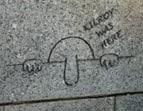Depending on your age, you may or may not have heard the phrase, Kilroy Was Here. With Veterans Day just two days away, I thought this might be a good time to share the fascinating story of the mysterious Mr. Kilroy.
The Man
Most people born between 1913 and 1950 have heard the phrase, Kilroy Was Here. Few, though, knew who Kilroy was or why “he was here.” In 1946, with World War II behind them, the American Transit Association decided to change that. Using their radio program, Speak to America, they sponsored a nationwide contest to find the real Mr. Kilroy.
Nearly forty men came forward claiming to be him, but only Halifax, Massachusetts’ James Kilroy had the evidence to prove his claim.
Did You Know…
- A real trolley car was promised to the man who could prove he was the real Kilroy.
- For Christmas 1946, the winner, the real Kilroy, gave his nine children the trolley car he’d won. It was placed in his yard and set up as a kid’s playhouse.
The Brand
So, who was Kilroy and why was he here? It started during WWII when he worked for the Fore River Shipyard. The shipyard paid their riveters by the rivet. Inspectors would check the number of rivets completed and turn the information into the company.
Not wanting the same rivets to be counted twice, 46-year-old shipyard inspector James Kilroy used a piece of semi-waxed lumber chalk to mark which blocks of rivets had been counted. Good idea. At least in theory. Turns out that after he left, the riveters erased his checkmarks and the next inspector counted the rivets again.
For a while, the shipyard paid these sneaky riveters double. But the unexpectedly higher wages didn’t go unnoticed. Kilroy’s boss called him in and tasked him with discovering the reason for the extra expense. It didn’t take him long to figure out what was happening. Once he did, he had to figure out how to solve the problem. Because many of the places he had to check were small spaces, taking a brush and paint can along to paint a checkmark wasn’t practical. Instead, he continued to use the waxy chalk, but rather than just place a checkmark, he added, KILROY WAS HERE, in large letters.
It worked. The riveters left Kilroy’s checkmark and message alone. They should have disappeared forever when the ship was painted. Only that’s not what happened. As the war raged, these ships—many of which carried troops—began to leave the shipyard unpainted. This left Kilroy’s inspection “brand” visible for thousands of soldiers to see.
Did You Know…
- The Fore River Shipyard originated on the Weymouth Fore River in Braintree, Massachusetts, in 1883, but moved to Quincy Point, Massachusetts, in 1901.
- Most of the ships built at the Fore River Shipyard were for the U.S. Navy.
The Joke
No one knew who Kilroy was, just that he’d been there before them. Overseas, troops encountered an English cartoon of a bald fellow. Soon these two things were combined and the Kilroy brand evolved into the Kilroy was here message with a sketch of a long-nosed man peeping over a fence.
 As a joke, troops began leaving this Kilroy brand wherever they were stationed, saying it was already there when they arrived. This military graffiti spread quickly around the globe. (Probably because troops were told not to do it.) And by the time the war ended, Kilroy had become a U.S. GI Superhero who’d been everywhere before the regular soldiers.
As a joke, troops began leaving this Kilroy brand wherever they were stationed, saying it was already there when they arrived. This military graffiti spread quickly around the globe. (Probably because troops were told not to do it.) And by the time the war ended, Kilroy had become a U.S. GI Superhero who’d been everywhere before the regular soldiers.
Did You Know…
- The paranoid Russian dictator Stalin, upon exiting an outhouse built exclusively for Roosevelt, Churchill, and Stalin, was heard asking his aide, “Who is Kilroy?”
- The Kilroy brand is said to be on the Statue of Liberty (New York), the underside of the Arc de Triomphe (Paris), and even on both the top of Mt. Everest and the surface of the moon.
- Two symmetrical Kilroy brands have been etched into the stone of small alcoves at the WWII Memorial in Washington, D.C.
The Result
So now you know. What started as a way to keep finances in check, morphed into a joke that proved to be an unexpected asset to the war effort.
The Kilroy brand provided a bit of comfort to servicemen who saw it as a sign that someone had been there before them and survived. And the myths surrounding this mysterious Kilroy gave the enemy something to worry about.
Did You Know…
- The German’s believed Kilroy was a superspy who could go anywhere he wanted.
- On at least one occasion, a U.S. underwater demolition team, secretly mapping a Japanese-held island for an upcoming U.S. invasion, reported seeing enemy troops painting over the Kilroy brand.


Very Interesting!!!
Thanks, Tal. Glad you enjoyed it.
Well, now I know! Great story.
Thanks, Bill. Yes, now you know.